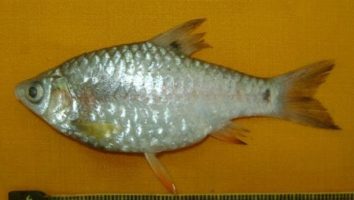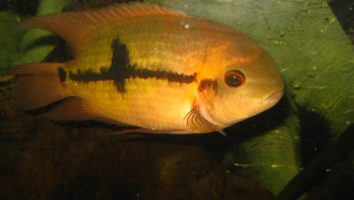The Betta (Siamese fighting fish) is a beautiful and popular freshwater fish for beginners that is easy to care for.
This species is relatively small so it can be kept in a smaller tank than some other freshwater fish.
However, they are known to be aggressive, so it’s important to choose tank mates carefully.
In this guide, we’ll teach you everything you need to know about Siamese fighting fish care. You’ll learn about their diet, tank mates, lifespan, and more!
Table of contents
Species overview
Siamese fighting fish (Betta splendens) are a freshwater fish that is native to Thailand, Cambodia, and Vietnam.
They are typically found in slow-moving waters like ponds, canals, and rice paddies.
Siamese fighting fish are best known for their long, flowing fins and their bright colors. They come in a wide variety of colors, including red, blue, green, and purple.
The Siamese fighting fish is a popular choice for aquariums because of its beauty. However, it is important to note that these fish are very aggressive and should not be kept with other fish.
Appearance

The first thing you’ll notice about this beautiful fish is their long fins. Both the male and female of this species have very long fins that can range in color.
The most popular color for Bettas is red, but you can also find them in shades of blue, green, orange, and even white.
The fins on the males are much longer than the females and are used in displays and fighting.
The body shape of a Betta is very sleek and hydrodynamic. This helps them to be very speedy when they need to be.
The majority of their body is covered in scales that have a beautiful iridescent sheen to them. This sheen is most pronounced on the males of the species.
The head of a Betta is very triangular with large eyes that sit on the sides. They have a small mouth that is downturned slightly.
Lifespan
In the wild, Bettas only have a lifespan of about 2 to 3 years. However, in captivity, they can live for up to 5 years with proper care.
The main contributing factor to a shorter lifespan in Bettas is the fighting. In the wild, they’re constantly fighting for territory and mates. This takes a lot out of them, both physically and mentally.
In captivity, they don’t have to worry about these things. As a result, they can live much longer and healthier lives.
Size
These beautiful fish can grow to be about 3 inches long from nose to tail, with the males being slightly larger than the females on average.
Tank
Tank Size
The minimum tank size for a betta fish is 2.5 gallons, but we recommend at least a 5 gallon tank if you can accommodate it. Bettas are a very popular fish but they often suffer in small tanks because people don’t realize how much space they need.
While a 2.5 gallon tank might be the minimum, it’s not going to give your fish a lot of room to move around or a lot of space to set up a proper environment.
Water Parameters
Bettas are one of the most popular freshwater fish for a reason: they’re beautiful, easy to care for, and fun to watch.
Despite their reputation as a “starter fish,” however, Bettas are still tropical fish. That means they require specific water parameters to stay healthy and thrive.
Luckily, these parameters aren’t too difficult to maintain. With a little bit of effort, you can create a perfect environment for your Betta fish.
- Water Temperature: 76 to 82 degrees Fahrenheit
- pH Levels: 6.5 to 7.5
- Water Hardness: 5 to 15 dGH
- Alkalinity Levels: 2-12 dKH
What To Put In Their Tank
When it comes to setting up the inside of an aquarium for a Siamese fighting fish there are a few key things to keep in mind.
First and foremost, these fish come from slow-moving waters in Southeast Asia. This means that they aren’t used to a lot of movement in their environment.
We recommend avoiding any decorations or substrate that will create a lot of movement in the water. This can be things like a bubbler or a powerhead.
Instead, go for something that will create a gentle flow. This can be accomplished with a sponge filter or an air stone.
Another important thing to remember is that these fish are used to living in close quarters with other fish. In the wild, they would often be found in rice paddies that were only a few feet wide.
This means that they don’t need a ton of space to feel comfortable. A 10-gallon tank is more than enough for a single fish.
When it comes to substrate, these fish don’t have any specific requirements. Gravel or sand will work just fine.
As for plants, you can include them if you want but it’s not necessary. These fish are known to nibble on vegetation so anything you put in their tank will likely be fair game.
Common Diseases
There are a few different diseases that can affect Siamese fighting fish. The most common one is probably velvet, which is a parasitic infection.
This disease is pretty easy to spot, as it will cause your fish to develop a gold or brownish tint to their skin. They may also scratch themselves a lot or have trouble breathing.
If you think your fish has velvet, the best thing to do is to take them to a vet. There is no real home treatment that is effective.
Another common disease is fin rot. This is caused by a bacteria and it will eat away at your fish’s fins. If you notice that your fish’s fins are looking ragged or torn, this is probably the culprit.
Fin rot is pretty easy to treat at home, however. You can buy a special bacteria treatment at your local pet store (make sure to follow the directions on the package).
The last disease we’ll mention is Swim Bladder Disease. This is a condition that affects the swim bladder, which is a internal organ that helps the fish control its buoyancy.
If this organ is damaged, the fish will have trouble swimming and may even float to the surface of the water.
Swim bladder disease is usually caused by a bacterial infection, but it can also be caused by physical trauma or a diet that is high in fat.
If you think your fish has swim bladder disease, the best thing to do is to take them to a vet. There is no real home treatment that is effective.
Behavior & Temperament
The Siamese fighting fish, also called the betta, is a beautiful creature that’s often coveted by fishkeepers. These fish are known for their vibrant colors, long fins, and unique personalities. They’re also relatively easy to care for, which makes them a great choice for beginner aquarists.
Despite their name, Siamese fighting fish are not naturally aggressive. In the wild, they live in rice paddies and slow-moving streams in Thailand, Vietnam, and Cambodia. These habitats are often crowded with other fish, so aggression is not beneficial for the betta.
However, when two males are placed in the same tank, they will often fight to the death. This is why it’s important to do your research before adding a betta to your aquarium.
When it comes to temperament, bettas can be a bit moody. They may be fine one day and aggressive the next. This is usually due to changes in their environment or stress from other tank mates. If you notice your betta becoming stressed, it’s important to remove the source of the stress to avoid aggression.
Tank Mates
The first thing to consider when choosing tank mates for Siamese fighting fish is that they are, well, fighting fish. They are named as such because they are aggressive and territorial. They will fight with other fish, and they may even fight with their own reflection!
Because of this, it’s important to choose tank mates that are either too large for the Siamese fighting fish to bother with, or that are fast enough to get away if the Siamese fighting fish does decide to attack.
Some good options for tank mates include:
- Tetras
- Guppies
- Mollies
- Platies
- Swordtails
- Rainbows
- Danios
Breeding
Betta fish are beautiful, unique, and relatively easy to care for… but did you know that they’re also easy to breed?
If you’re thinking about breeding your own Bettas, the first thing you need to do is choose the right pair. It’s best to pick a male and female that have similar coloring. This will help to produce more colorful offspring.
The next step is to set up a breeding tank. It should be at least 5 gallons and contain plenty of hiding places. Java moss is a good option.
You’ll also need to add a bubble nest. This is where the male Betta will deposit his eggs. To make a bubble nest, simply put an air stone in the tank and let it run for a few hours.
Once the tank is set up, introduce the male and female. It’s best to do this at night so they have time to adjust to their new surroundings.
The males will build the bubble nest and then court the female. When she’s ready to spawn, she’ll allow him to wrap his body around hers.
Once they’re ready, the male will release his sperm and the female will release her eggs. The eggs will float to the surface and stick to the bubbles.
After spawning is complete, it’s best to remove the parents. They may eat the eggs or fry if left in the tank.
The eggs will hatch in about 24-36 hours. You can feed the fry live baby brine shrimp or microworms.
Conclusion
As you can see, there are many benefits to owning a Siamese fighting fish. They are beautiful fish that come in a wide variety of colors and patterns. They are also relatively easy to care for and make great additions to community tanks.
The only downside to owning a Siamese fighting fish is that they can be aggressive towards other fish. This is usually only a problem if you don’t provide them with enough space or if you don’t introduce them to other fish properly.
Overall, we think Siamese fighting fish make great pets and we highly recommend them to anyone looking for a beautiful and relatively easy to care for fish.












